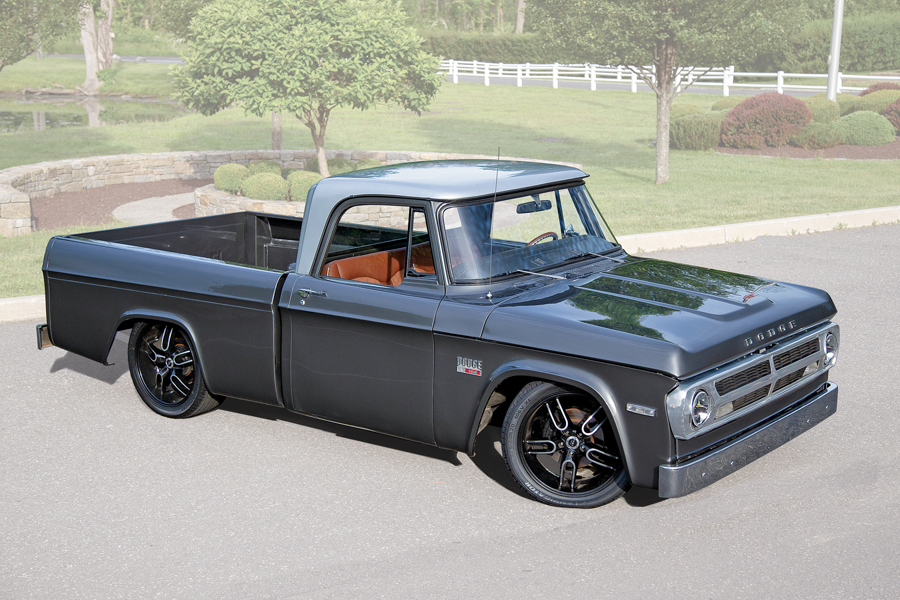- Dodge D100 Sweptline with wood bed floor
- Magnum 360-ci V8
- Automatic transmission
- Two-tone silver paint
- 20-inch wheels
- Air conditioning
- Power steering and brakes
- Four-wheel disc brakes
- Independent front suspension
- Stereo
- Backup camera
SCM Analysis
Detailing
| Vehicle: | 1970 Dodge D100 pickup |
| Years Produced: | 1965–71 |
| Number Produced: | 15,978 (1970, 114-inch wheelbase) |
| Original List Price: | $2,690 (base) |
| SCM Valuation: | $21,450 |
| Tune Up Cost: | $200 (estimated) |
| Chassis Number Location: | Tag on driver’s side door jamb |
| Engine Number Location: | Driver’s side of the block, underneath the cylinder head |
| Alternatives: | 1967–72 Ford F-series, 1967–72 Chevrolet C-series, 1969–75 International D-series |
| Investment Grade: | C |
This truck, Lot 347.1, sold for $27,500, including buyer’s premium, at Barrett-Jackson’s Northeast 2019 auction in Uncasville, CT, on June 28, 2019.
While comparable Chevys and Fords go for $30k and much higher, this truck came out as a virtual steal.
The missing pickup truck
You might say that Dodge just played the long game wrong. They introduced the second generation of Dodge D100s in 1965, two years before Chevy and Ford would introduce their models.
In Dodge’s take on what consumers of the time wanted, that meant a very square, capable truck. But when the 1967 C10 and F-100 were introduced, the D100 all of a sudden looked antiquated in comparison. It was what a truck used to look like. That put Dodge on the run.
In 1968, Dodge decided to make some changes, likely in response to the market. They changed the grille to look more modern and started adding some more “luxurious” features — such as carpet. New trim levels, including Adventurer, Adventurer Sport and Adventurer SE, came with more choices as well. Cleaner door-panel trim, woodgrain dashboards and even color-keyed seat belts were all available. By then, however, the competition was far more appealing. Dodge just made the move too late.
Breaking the mold
That brings up the obvious question: What makes these trucks desirable today? For the most part, they’re still not. A comparable C10 or F-100 will always fetch more money, and there are a lot of those on the market to choose from. Interestingly enough, though, the sheer number of GM and Ford trucks out there is part of the reason why Dodges are popular with some buyers.
D100s are cheap. Unrestored models are out there for under $5,000 all day long. And when they’re completed, the resulting truck can be had for under $30k, which can still generate a profit for the builder. At that price, it’s appealing for the buyer, too.
On top of that, Dodge trucks are just different. Anyone can go to their local car show and see a half-dozen C10s. At that same show, a Dodge stands out from the crowd.
Plus, through today’s lens, the D-series is not a bad-looking truck. The truck is very clearly boxy, and that look is amplified (for the better) when it’s modified.
In this case, that’s part of the appeal. Because it’s a Dodge, and because it’s modified, and because it has a great engine, it’s a good buy. The new owner can pull up to that same local car show next time and get a ton of looks and the obvious question: “But what is it?”
Standing out can be a good thing
We don’t know what the original builder’s intent was, but it’s safe to hazard a few guesses. As a custom-truck builder, the motivation may have been simple: Make it cool. But if it was for resale, then modifying the truck past stock would give it a higher profile.
Thing is, it’s not heavily modified in comparison with other custom trucks. It doesn’t lay the frame on the ground, nor does it have airbags. The interior is clean and upgraded, but it’s not gaudy. The paint is simple. It’s a nicely restored truck with a few mods — some that could be easily removed if desired.
The other tricks, such as the independent front suspension, are an upgrade made for better handling and, arguably, safety. That’s probably the kicker with this particular truck. Its modifications give it an edge compared to the competition, but the fact that it’s not so modified that it could appear in a movie with “Fast” or “Furious” in the title means that it’s still manageable for the average consumer.
The down low
Bottom line: Is this a good deal? Fans of these trucks tend to want the earlier years, pre-1960. Those can bring in some fairly decent numbers, some of which are climbing into the $50k–$70k range.
But this particular generation of trucks just isn’t that hot. Most of them stick around the $20,000 mark at sale time and don’t go much higher. So on the one hand, the seller here made out pretty well, although one has to consider how much was spent on modifications. But on the other hand, the buyer got an awful lot of truck for $30k. And when compared to the values of C10s and F-100s done to the same level, it was a really good deal.
(Introductory description courtesy of Barrett-Jackson.)
